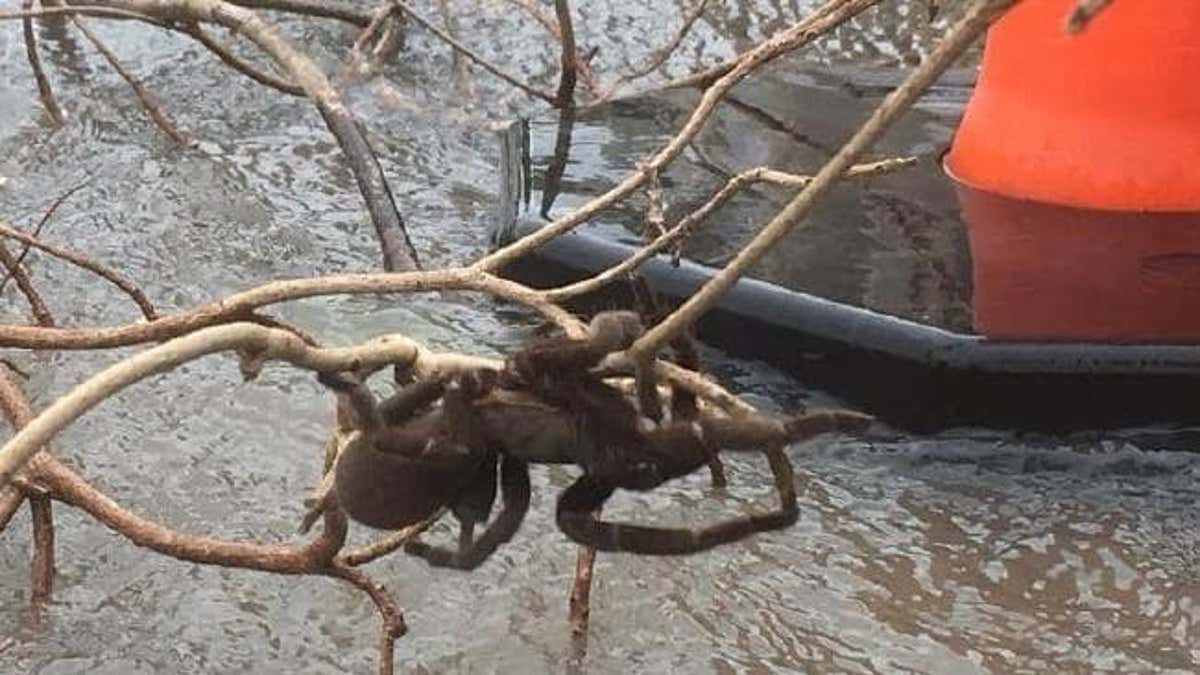
The enormous spider found precariously perched above a flooded river in Halifax, Queensland. (Picture: Andrew Giliberto)
It really does sound like something from a horror movie: a giant spider larger than a man’s hand, which makes loud hissing sounds and has powerful long venomous fangs.
While many people would run the other way when face-to-face with such an enormous arachnid, a group of North Queensland locals did the opposite and saved the terrifying creature when it was found dangling for dear life on a branch overhanging flooded water.
The spider is believed to be a whistling spider (Australian tarantula) — the name relates to the sound they make when feeling threatened. They are also known as bird-eating spiders.
Found in the warmer and more arid regions of Australia, the largest species can grow a body length of 2 inches and a leg span of 4 inches, with powerful fangs 0.4 inches long.
“They are large to very large grey or brown spiders that are very hairy with two finger-like spinnerets at the end of the body. Thick hair pads on their legs and ‘feet’ allow these spiders to easily climb glass or smooth plastic walls,” explained Queensland Museum.
The habitat of the whistling spider ranges from sandy deserts to rainforests, with the creature constructing long, silk-lined burrows surrounded by loose strands of web to give advanced warnings of approaching prey or danger.
Despite being dubbed the “bird-eating spider”, the tarantula rarely eats birds — the bulk of the diet comprises insects, lizards, frogs, and other spiders.
Tarantulas can be quite aggressive if mishandled and even though their fangs are long and robust, they are not deadly to humans.
“Their bite is quickly fatal to dogs and cats, but only one report of serious illness from a bite to a human has occurred,” explained Queensland Museum.
The female bird-eating spider spends most of her life in her burrow, although will exit during early spring and summer when the males approaches to mate.
Females lay around fifty eggs into a 1-inch diameter sack, which is stored in the burrow and protected by a tough cover of silk. Although, the female will often secure the sack between her palps and fang tips to take it with her when she leaves to hunt.
Sadly male tarantulas usually die after mating at around five years of age, while females can live up to 30 years.
The spider captured on camera over the weekend was found perched precariously on a flimsy twig in a desperate attempt to stay away from the Herbert river in Halifax, near Ingham, engorged following a week of torrential rain in that section of Australia.
In the past four days, the sheer amount of rainfall has seen the region between Townsville and Cairns declared a disaster zone by the state government. Queensland’s north west is suffering through the worst flooding since 2009.
The area close to Halifax has seen more than 500mm of rain since March 1.
Andrew Gilberto uploaded the video of the spider, which was spotted close to Halifax’s Spar supermarket.
Channel 9 reported that the locals, clearly with a soft spot for the creature, plucked the branch from above the river with the spider attached.
It was then placed on an avocado tree in the town center away from the flooded waters; but significantly closer to humans.
It’s not the only critter spotted in the floodwaters. Video has also been uploaded of snakes in the river while a crocodile lunged at a car.
It comes as a group of Year 6 students who had been isolated by floodwaters were today being flown out in an evacuation timed to beat more wet weather expected, reported the Courier Mail.
More than 70 students and staff had been trapped at the Echo Creek adventure park near Tully since last Monday.
The first group of the staged rescue was flown out before noon.
The Bureau of Meteorology says the weekend’s heavy rain is now easing, however there are signs a cyclone may be forming off the state’s far north coast. This could have devastating effects on already damage-stricken regions.
This story originally appeared in news.com.au.




















